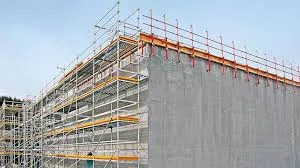Ago . 01, 2024 02:34 Back to list
Innovative Solutions for Scaffold Production in the Industrial Manufacturing Sector and Beyond
The Role of Scaffolds in Industrial Manufacturing
In the realm of industrial manufacturing, safety, efficiency, and innovation are paramount. One of the critical components that enhance these aspects is scaffolding. Scaffolds are essential structures that provide support and access for workers during the construction, maintenance, or renovation of industrial facilities. Understanding the role of scaffolds in industrial manufacturing not only underscores the importance of safety but also emphasizes the efficiency and effectiveness they bring to various processes.
Safety First
First and foremost, scaffolding systems are designed with safety in mind. The industrial environment, characterized by heavy machinery, elevated heights, and various hazards, necessitates robust safety measures. Scaffolds, when professionally installed, enable workers to perform their tasks with reduced risk of falling or being injured. They are constructed using durable materials that can withstand considerable weight, providing a stable platform for labor-intensive projects. Safety regulations mandate the proper use of scaffolds, including regular inspections to ensure structural integrity. This focus on safety is crucial as it not only protects workers but also reduces costs associated with accidents and downtime.
Efficiency and Access
In addition to enhancing safety, scaffolds significantly improve efficiency in industrial manufacturing. Many manufacturing processes involve complex tasks that require workers to access elevated platforms or confined spaces. Scaffolding provides the necessary support to reach these areas safely and effectively. For example, during the maintenance of large industrial equipment or the construction of high-rise facilities, scaffolds offer a quick and adaptable solution, allowing teams to work simultaneously on different sections of a project. The modular nature of modern scaffolding systems means they can be easily erected and dismantled, saving valuable time and resources.
Moreover, scaffolds can be customized to meet the specific needs of a project. Whether it is a short-term maintenance task or a long-term construction project, scaffolding systems can be tailored to accommodate various heights, shapes, and load requirements. This flexibility ensures that industrial manufacturers can optimize their work processes, minimize delays, and enhance productivity.
scaffolds industrial manufacturer

Innovation in Scaffold Design
As industries evolve, so do the designs and materials used in scaffolding. Advances in technology have led to the creation of lightweight, high-strength materials that improve the overall performance of scaffolding systems. Innovations such as composite materials and modular designs have not only enhanced safety but also contributed to the speed and ease of assembly. Additionally, modern scaffolds often include features like integrated safety rails, loading platforms, and built-in platforms for tools and materials, further improving worker efficiency.
Environmental Considerations
In today’s manufacturing landscape, environmental sustainability is becoming increasingly important. Scaffolding manufacturers are now focusing on eco-friendly materials and processes. Reusable scaffolding systems reduce waste while promoting sustainability in construction and maintenance operations. Furthermore, the efficiency of scaffolds can lead to less energy consumption during industrial processes, contributing to a lower overall carbon footprint.
Conclusion
In conclusion, scaffolds play a vital role in industrial manufacturing, encompassing safety, efficiency, innovation, and environmental consideration. As the industry continues to grow and evolve, the importance of robust scaffolding systems will only increase. By investing in quality scaffolds, manufacturers not only ensure the safety of their workers but also enhance operational efficiency, paving the way for future innovations in engineering and construction. Whether it is for maintenance, construction, or renovation, scaffolds remain an indispensable element in the field of industrial manufacturing, supporting progress one structure at a time.
-
Climbing Formwork for High-Rise Buildings Durable, Time-Saving Solutions
NewsApr.29,2025
-
Metal Concrete Shuttering Solutions Durable Manufacturer & Exporter
NewsApr.29,2025
-
Jump Formwork Solutions Durable, Modular & Cost-Effective
NewsApr.29,2025
-
Ringlock Scaffolding Systems Durable & High-Capacity Solutions
NewsApr.28,2025
-
H20 Beams with Protection Cap Durable Supplier Solutions
NewsApr.28,2025
-
Inclined Column Formwork Suppliers Durable & Custom Solutions
NewsApr.28,2025